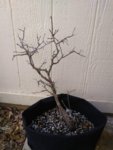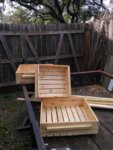ThirdCoastBorn
Sapling
I went on my first club collection dig this past weekend and had a blast (no idea what to expect), ended up with three small native species. I'm fortunate to be blessed with a great local group of knowledgeable/friendly/helpful members, but sometimes I worry of peppering them with incessant questions! So here are a few for y'all...
- For (pre-trip) planning purposes, is there any rough guideline between the number/size of trees (perhaps 'total trunk caliper of collected material') and volume of prepared soil? I thought I had MORE than enough pre-sifted, and lo and behold, was furiously sieving at midnight, just enough to be able to cover the roots and call it a night.
- How do individuals match container size to the base material ? Roped a friend into helping me pre-build two 2'x2'x5.5" and one 18"x18"x"5.5" cedar containers, which seemed way too large relative to what I collected. How large of material should I be looking at for the club's next upcoming dig? Only the Gum Bumelia has a root structure that appropriately fits in the smaller container (most of it being a large horizontal root)...
- How common/rare is it to use rooting hormones at the root ends of collected material? I'm holding off for now, but figure ~1% IBA could be helpful, particularly at chop points of major root lines?
- Two of the three trees are completely bare, whereas one has just barely started budding out. Do 'standard' aftercare recommendations of full/partial shade for X number of weeks, equally apply for them all or is as much photosynthesis as possible, ASAP, the goal?
Thanks in advance everyone, for any and all advice.
- For (pre-trip) planning purposes, is there any rough guideline between the number/size of trees (perhaps 'total trunk caliper of collected material') and volume of prepared soil? I thought I had MORE than enough pre-sifted, and lo and behold, was furiously sieving at midnight, just enough to be able to cover the roots and call it a night.
- How do individuals match container size to the base material ? Roped a friend into helping me pre-build two 2'x2'x5.5" and one 18"x18"x"5.5" cedar containers, which seemed way too large relative to what I collected. How large of material should I be looking at for the club's next upcoming dig? Only the Gum Bumelia has a root structure that appropriately fits in the smaller container (most of it being a large horizontal root)...
- How common/rare is it to use rooting hormones at the root ends of collected material? I'm holding off for now, but figure ~1% IBA could be helpful, particularly at chop points of major root lines?
- Two of the three trees are completely bare, whereas one has just barely started budding out. Do 'standard' aftercare recommendations of full/partial shade for X number of weeks, equally apply for them all or is as much photosynthesis as possible, ASAP, the goal?
Thanks in advance everyone, for any and all advice.



